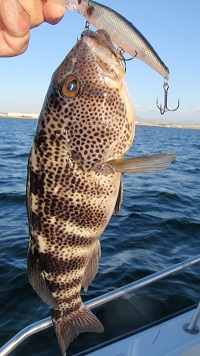Spotted bay bass
 Spotted sand (bay) bass range from the Gulf of California, Mexico to Monterey, California (with an occurrence Nicaragua). This species is also found primarily south of Point Conception, California. Interestingly, the Gulf of California population and the southern California/northern Baja population appear to be genetically distinct. Spotted sand bass in the Gulf of California are sequential hermaphrodites capable of changing sex from female to male. The San Diego Bay population has also shown signs of sex changing, but populations at other sites in the southern California region do not seem to exhibit this trait. Spotted sand bass prefer shallow, sheltered, soft bottom and eelgrass habitat in bays, harbors, and estuaries where they feed primarily on small crabs, bivalves, and small fishes. This species is faster growing and shorter lived than kelp bass or barred sand bass, and successful reproduction seems to occur from June-August during the years of warmest sea surface temperatures. They mature very early at approximately 1-2 years, or 6-7 inches (standard length), which is about 7-8 inches total length. They grow extremely fast during their first two years, but a legal-sized fish is about 8-10 years old. It is unclear whether this species forms annual spawning aggregations, or whether they are simply group spawners similar to kelp bass. The recreational fishery is almost exclusively catch-and-release by private boaters, so fisheries data for this species are very limited because this fishing group is not monitored as thoroughly as the CPFV fleet. Fishing impacts for spotted sand (bay) bass are likely relatively low because most fishing is by private boaters and shore anglers only, most people only target them for catch-and-release (approximately 94% of the catch is released), they are fast growers, and there are several years of sexual maturity before they reach legal size.
Spotted sand (bay) bass range from the Gulf of California, Mexico to Monterey, California (with an occurrence Nicaragua). This species is also found primarily south of Point Conception, California. Interestingly, the Gulf of California population and the southern California/northern Baja population appear to be genetically distinct. Spotted sand bass in the Gulf of California are sequential hermaphrodites capable of changing sex from female to male. The San Diego Bay population has also shown signs of sex changing, but populations at other sites in the southern California region do not seem to exhibit this trait. Spotted sand bass prefer shallow, sheltered, soft bottom and eelgrass habitat in bays, harbors, and estuaries where they feed primarily on small crabs, bivalves, and small fishes. This species is faster growing and shorter lived than kelp bass or barred sand bass, and successful reproduction seems to occur from June-August during the years of warmest sea surface temperatures. They mature very early at approximately 1-2 years, or 6-7 inches (standard length), which is about 7-8 inches total length. They grow extremely fast during their first two years, but a legal-sized fish is about 8-10 years old. It is unclear whether this species forms annual spawning aggregations, or whether they are simply group spawners similar to kelp bass. The recreational fishery is almost exclusively catch-and-release by private boaters, so fisheries data for this species are very limited because this fishing group is not monitored as thoroughly as the CPFV fleet. Fishing impacts for spotted sand (bay) bass are likely relatively low because most fishing is by private boaters and shore anglers only, most people only target them for catch-and-release (approximately 94% of the catch is released), they are fast growers, and there are several years of sexual maturity before they reach legal size.
